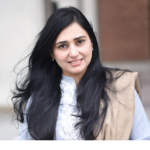 Gulalai Khan, an internet governance policy specialist who teaches at the University of Lahore, writes here about the issues raised by the upcoming 5G auction in Pakistan.
Gulalai Khan, an internet governance policy specialist who teaches at the University of Lahore, writes here about the issues raised by the upcoming 5G auction in Pakistan.
Pakistan’s digital ecosystem is once again bubbling with excitement and anticipation as the caretaker government has announced ambitious plans to get the 5G auction completed within the next 10 months. This announcement comes after an earlier attempt in 2021 which was unsuccessful due to high prices and tough policy conditions under the then government’s Digital Pakistan Initiative.
The Government of Pakistan views the 5G auction as an impetus for growth both economically and technologically, and experts believe that the push is inevitable for the digital transformation that Pakistan aspires for. However, the complexities surrounding the 5G auction with industry and financial concerns are not easy to ignore. While commendable, the government’s ambition to embrace cutting-edge technology ought to be balanced against the country’s economic realities and the costs associated with roll-out and adaptation. It should seriously evaluate the untapped potential of 4G, which could be more easily accessible to populations, including those who currently lack connectivity.
Failed Initial Auction and Economic Constraints
South Asia as a whole is considered the key region that will propel the global 5G revolution forward due to its high population and young users. Yet, glaring economic disparities among and within the countries—including those trenchant in Pakistan—are complicating matters.
In 2021, Pakistan attempted to auction 5G spectrum licenses, but the endeavour was marred by multiple issues. The primary issue was the unwillingness of the Cellular Mobile Operators (CMOs) to participate in such a high-cost 5G auction as they believed the telecoms landscape was not yet ready and the business case for such a rollout was not feasible. The Government of Pakistan, after witnessing the successful auction of the spectrum in two major economies of the region, India and Bangladesh, probably miscalculated the readiness of the country at that time.
The last two years in particular have been economically challenging for Pakistan, especially with regard to foreign exchange reserves and thus the Letters of Credits (LC) issues for businesses. The 5G auction is estimated to be around $330 million or more and the telcos are not sure they can pay this due to the heavy taxes imposed on them, among the highest in the region. In addition, high tax on imported 5G receptive phones from the Pakistan Telecommunication Authority (PTA), infamously known as the PTA tax, is also considered a main reason why the 5G affordability and uptake might be an issue. Currently, the percentage of 5G-supported handsets in the country is less than one percent.
The telecom industry, as a capital-intensive sector, heavily relies on imported technology and equipment. The rapid deployment of 5G would require substantial investments in infrastructure and equipment, which can be challenging at this time and only those with deep pockets will be able to ensure that the necessary work goes ahead.
A Lukewarm Reception from Big Players
At the turn of the new millennium, Pakistan’s telecoms market started taking baby steps to transition from a regulated state-owned monopoly to a deregulated competitive structure. The transition, and the development of the telecom sector generally, saw an influx of foreign investment with many international telcos setting up shop in the country that showed an intent to open up to new technologies. Major telecoms in the country are all foreign-owned, with one which is military operating in two remote regions. Almost all telecoms companies are criticised for slow or patchy internet services depending on geography and location. The fixed-line telephony market, dominated by Pakistan Telecommunications Limited (PTCL), has shown a decline in the number of fixed lines. Meanwhile, with a huge youth bulge comprising of almost 54 per cent of the total population, the mobile market has experienced moderate growth over the last decade.
The government is looking to the telecoms sector to grow 5G. Jazz, one of Pakistan’s leading telecom operators with a market share of 38%, ran a 5G test and also showcased its 5G capacity with 5G compatible devices in 2019. However, the company has been an outspoken critic of the rush towards 5G. Their priority lies with improving 4G access throughout the country where 4G rollout is still not complete. Note that Jazz, which grew from a merger between Mobilink and Warid Pakistan, remains competitive by selling cheap data in volume to consumers with low-bandwidth devices. Jazz also has a significant share of the mobile financial services market with its subsidiary JazzCash, which offers lines of credit and microloans to subscribers and scratchcards. Another player, Telenor, is also in the running but finances are a big hindrance.
The government is hopeful that apart from the old players, new investors might also be interested when the auction takes place. It views this auction as a massive injection of money in a struggling economy and an advisory committee under the finance minister has already been established. There is also market speculation that the Chinese-owned Zong might ultimately be able to offer the highest bid due to more cash and access. The company has already run a 5G test in Pakistan partnering with Beijing Mobile, establishing itself as a 5G ready company. Insiders talk about Zongratulating Zong instead of congratulating them once the auction happens but with the recent approval of the country’s first ever telecom infrastructure sharing framework, new players cannot be ruled out.
4G v. 5G: A Path towards Greater Connectivity?
While the promise of auction revenue remains deeply attractive, many in the telecommunications landscape have their doubts, and speculate that 4G might be a better path forward.
They see 4G technology as more affordable than 5G, making it accessible to a broader segment of the population. In a country with significant income disparities, ensuring affordable and widespread internet access should be a priority. This is also coupled with the cost of 5G devices which remain out of the reach of the majority: 90 percent of mobile devices assembled in the country are 2G and 3G compatible.
Critics also express concerns about significant infrastructure upgrade required by 5G, including the installation of new towers and equipment. In contrast, enhancing 4G infrastructure would be less capital-intensive and more feasible, especially in remote and underserved areas where majority are still unconnected. In addition to this a preferred fibre option for 5G would mean massive investment for infrastructure which might not be the option currently for existing organisations.
Finally, many feel that the wait-time for 4G would be minimal in comparison with 5G. Improving 4G access would see an immediate boost in internet connectivity, benefiting education, healthcare, and businesses. 5G would require deep pockets and take time to build. There have been suggestions about policy on 5G for a few and 4G for all but the fear of this deepening the already wide digital divide in terms of opportunity is real.
The Political and Policy Angle
The recent announcement has generated an alternate non-technical, more political debate on the mandate of a caretaker government taking up what should be the work of an elected government. However, analysts believe that this caretaker setup might last longer than the than the stipulated 90 days period due to the constituency delimitation work after census. This auction issue has already been fixed through the caretaker cabinet’s approval for the auction as well as the approval of the telecom infrastructure sharing framework which will allow telecoms to jointly utilise resources and infrastructure to cut down operational costs. Many believe that this is also being done with the ambition to make the telecom sector more attractive to Foreign Direct Investment and increase competition when the bids are launched. The industry reaction on this is still awaited. The military set-up of Pakistan, which many believe is a major decision-maker on investments especially after the newly established Special Investment Facilitation Council, is thought to be firmly behind this decision and would guide the process effectively.
The debate over Pakistan’s move towards 5G is multifaceted, involving economic, technological, adaptability and even political considerations. While the government’s ambition would make life and work easier for the thousands of freelancers and IT businesses in the country, who contribute significantly to the export economy, it is essential to keep in mind the wider economic realities as well as the urban- rural digital disparity considerations.. The developments will be interesting to see especially in a world where although 5G is still its infancy, conversations and experiments have already begun for 5.5 and 6G.
This post represents the views of the author and not the position of the Media@LSE blog, nor of the London School of Economics and Political Science.
Featured image: Photo by Alina Grubnyak on Unsplash





